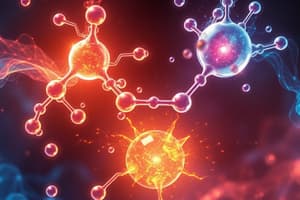Podcast
Questions and Answers
What type of cleavage results in one fragment receiving both electrons from the broken bond?
What type of cleavage results in one fragment receiving both electrons from the broken bond?
What is a species with a carbon atom possessing a sextet of electrons and a positive charge called?
What is a species with a carbon atom possessing a sextet of electrons and a positive charge called?
Which of the following is a tertiary carbocation?
Which of the following is a tertiary carbocation?
What is the observed order of carbocation stability from least to most stable?
What is the observed order of carbocation stability from least to most stable?
Signup and view all the answers
What hybridization is observed in a carbocation?
What hybridization is observed in a carbocation?
Signup and view all the answers
What stabilizing effects contribute to carbocation stability?
What stabilizing effects contribute to carbocation stability?
Signup and view all the answers
What defines the term 'substrate' in an organic reaction?
What defines the term 'substrate' in an organic reaction?
Signup and view all the answers
What is formed after the heterolytic cleavage of a covalent bond in bromomethane?
What is formed after the heterolytic cleavage of a covalent bond in bromomethane?
Signup and view all the answers
In an organic reaction, the organic molecule is also referred to as a ______.
In an organic reaction, the organic molecule is also referred to as a ______.
Signup and view all the answers
Heterolytic cleavage results in one fragment having a ______ charge.
Heterolytic cleavage results in one fragment having a ______ charge.
Signup and view all the answers
A carbocation with one carbon directly attached is classified as a ______ carbocation.
A carbocation with one carbon directly attached is classified as a ______ carbocation.
Signup and view all the answers
The structure of carbocations is typically ______ planar.
The structure of carbocations is typically ______ planar.
Signup and view all the answers
Alkyl groups stabilize carbocations through inductive and ______ effects.
Alkyl groups stabilize carbocations through inductive and ______ effects.
Signup and view all the answers
After heterolysis of bromomethane, the products are CH3 and ______.
After heterolysis of bromomethane, the products are CH3 and ______.
Signup and view all the answers
The positive charge in a carbocation is carried by a carbon atom with a sextet of ______.
The positive charge in a carbocation is carried by a carbon atom with a sextet of ______.
Signup and view all the answers
The observed order of carbocation stability is C+H3 < CH3C+H2 < ______.
The observed order of carbocation stability is C+H3 < CH3C+H2 < ______.
Signup and view all the answers
Flashcards
Organic Reaction
Organic Reaction
A reaction where an organic molecule (substrate) reacts with a reagent to form intermediate(s) and final product(s).
Substrate
Substrate
The reactant in an organic reaction which provides carbon for the new bond.
Reagent
Reagent
The reactant in an organic reaction that attacks the substrate.
Heterolytic Cleavage
Heterolytic Cleavage
Signup and view all the flashcards
Carbocation
Carbocation
Signup and view all the flashcards
Carbocation Stability
Carbocation Stability
Signup and view all the flashcards
Primary Carbocation
Primary Carbocation
Signup and view all the flashcards
Tertiary Carbocation
Tertiary Carbocation
Signup and view all the flashcards
Homolytic Cleavage
Homolytic Cleavage
Signup and view all the flashcards
Radicals
Radicals
Signup and view all the flashcards
Secondary Carbocation
Secondary Carbocation
Signup and view all the flashcards
Study Notes
Organic Reactions
- Organic molecules (substrates) react with reagents to form intermediates and products.
- A reactant supplying carbon to a new bond is the substrate. If both reactants contribute, the choice is arbitrary.
- Reactions involve breaking a carbon-carbon or carbon-other atom bond and forming a new bond.
- Reaction mechanisms detail each step, electron movement, energy changes, and reaction rates.
Bond Cleavage
- Covalent bonds can cleave through heterolytic or homolytic fission.
- Heterolytic cleavage: The shared electron pair remains with one fragment.
- Heterolysis creates a positively charged fragment (sextet) and a negatively charged fragment (octet).
- Example: Bromomethane (CH3Br) heterolytically cleaves into CH3+ and Br-.
- A carbocation is a carbon with a sextet and a positive charge.
- Carbocation classifications:
- Primary (one carbon attached)
- Secondary (two carbons attached)
- Tertiary (three carbons attached)
- CH3+ (methyl cation) is a primary carbocation.
- Carbocations are highly unstable and reactive.
- Alkyl groups stabilize carbocations through inductive and hyperconjugation effects.
- Carbocation stability: Methyl < Ethyl < Isopropyl < Tert-butyl
- Carbocation shape: Trigonal planar (sp2 hybridized carbon).
Studying That Suits You
Use AI to generate personalized quizzes and flashcards to suit your learning preferences.
Description
Explore the fundamental concepts of organic reactions, including the roles of substrates and the details of reaction mechanisms. This quiz delves into bond cleavage types, such as heterolytic and homolytic fission, and provides insights into carbocation classifications. Test your understanding of these essential organic chemistry topics.




